Human cornea proteome: identification and quantitation of the proteins of the three main layers including epithelium, stroma, and endothelium
- PMID: 22698189
- PMCID: PMC3411198
- DOI: 10.1021/pr300358k
Human cornea proteome: identification and quantitation of the proteins of the three main layers including epithelium, stroma, and endothelium
Abstract
Diseases of the cornea are common and refer to conditions like infections, injuries and genetic defects. Morphologically, many corneal diseases affect only certain layers of the cornea and separate analysis of the individual layers is therefore of interest to explore the basic molecular mechanisms involved in corneal health and disease. In this study, the three main layers including, the epithelium, stroma and endothelium of healthy human corneas were isolated. Prior to analysis by LC-MS/MS the proteins from the different layers were either (i) separated by SDS-PAGE followed by in-gel trypsinization, (ii) in-solution digested without prior protein separation or, (iii) in-solution digested followed by cation exchange chromatography. A total of 3250 unique Swiss-Prot annotated proteins were identified in human corneas, 2737 in the epithelium, 1679 in the stroma, and 880 in the endothelial layer. Of these, 1787 proteins have not previously been identified in the human cornea by mass spectrometry. In total, 771 proteins were quantified, 157 based on in-solution digestion and 770 based on SDS-PAGE separation followed by in-gel digestion of excised gel pieces. Protein analysis showed that many of the identified proteins are plasma proteins involved in defense responses.
Figures
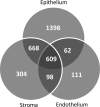
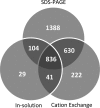
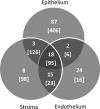
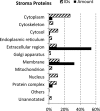

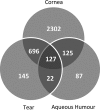
References
-
- Patel S.; McLaren J.; Hodge D.; Bourne W. Normal human keratocyte density and corneal thickness measurement by using confocal microscopy in vivo. Invest. Ophthalmol. Vis. Sci. 2001, 42(2), 333–9. - PubMed
-
- Kolozsvari L.; Nogradi A.; Hopp B.; Bor Z. UV absorbance of the human cornea in the 240- to 400-nm range. Invest. Ophthalmol. Vis. Sci. 2002, 43(7), 2165–8. - PubMed
-
- Lu L.; Reinach P. S.; Kao W. W. Corneal epithelial wound healing. Exp. Biol. Med. (Maywood) 2001, 226(7), 653–64. - PubMed
-
- Karring H.; Thogersen I. B.; Klintworth G. K.; Moller-Pedersen T.; Enghild J. J. A dataset of human cornea proteins identified by Peptide mass fingerprinting and tandem mass spectrometry. Mol. Cell. Proteomics 2005, 4(9), 1406–8. - PubMed
Publication types
MeSH terms
Substances
Grants and funding
LinkOut - more resources
Full Text Sources
Other Literature Sources

